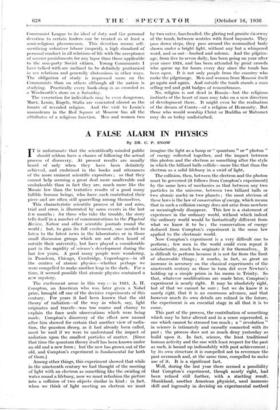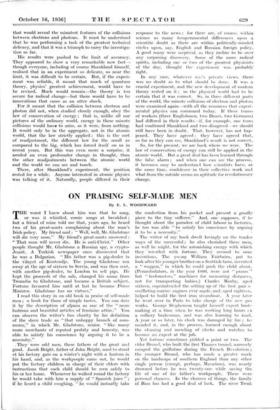A FALSE ALARM IN PHYSICS
By DR. C. B. SNOW
I T is unfortunate that the scientifically -minded public should seldom have a chance of following the actual process of discovery. At present results are usually heard of only when they have been definitely achieved, and enshrined in the books and utterances of the more eminent scientific expositors ; so that they cannot help seeming a great deal more unalterable and unshakeable than in fact they are, much more like the Mosaic law than the tentative results of a good many fallible human beings, who -have ;each contributed their piece and are often still quarrelling among themselves.
This characteristic scientific process of hit and miss, trial and error, is illustrated by some events in the last few months ; for those who take the trouble, the story tells itself in a number of communications to the Physical Review, Nature and other scientific journals round the world ; but, to gain its full excitement, one needed to listen to the latest news in the laboratories or in those small 'discussion groups which are not often heard of outside :their university, but have played a considerable part in the rapidity of science's development during the last few years. A good many people were wondering, in Pasadena, Chicago, Cambridge, Copenhagen—in all the centres of atomic physics—whether perhaps we were compelled to make another leap in the dark. For a time, it seemed possible that atomic physics contained a new mystery.
The excitement arose in this way :—in 1924, A. H. Compton, an American who was later given a Nobel prize, brought off one of the decisive experiments of this century. For years it had been known that the old theory of radiation—of the way in which, say, light originates and travels—was too coarse and clumsy to explain the finer scale observations which were being made. Compton's discovery of the effect now named after him showed for certain that another view of radia- tion, the quantum theory, as it had already been called, must be used if we were to understand the impact of radiation upon the smallest particles of matter. (Since that time the quantum theory itself has been known under an old and a new form ; but the new has grown out of the old, and Compton's experiment is fundamental for both of them.) Among other things, this experiment showed that while in the nineteenth century we had thought of the meeting of light with an electron as something like the swirling of water round a lifebuoy, now we must refashion the picture into a collision of two objects similar in kind : in fact, when we think of light meeting an electron we Must imagine the light as a lump or" quantum" or " photon" of energy collected together, and the impact• between this photon and the electron as something after the style in which the billiard balls collide—more like that than the electron as a solid lifebuoy in a swirl of light.
The collision, then, between the electron and the photon must he governed (ii follows from Compton's experiment) by the same laws of mechanics as that between any two particles in the universe, between two billiard balls or two, atomic nuclei or two 'planets ; the most obvious of these laws is the law of conservation of energy, which means that in such a collision energy does not arise from nowhere or meaninglessly disappear. This law is a statement of experience in the ordinary world, without which indeed the ordinary world would be fantastically different from what we know it to be ; the conservation of energy deduced from Compton's experiment is the same law applied to the electronic world.
Now Compton's experiment is' a very difficult One ,to perform ; few men in the world could even repeat it satisfactorily, much less originate it for themselves., It is difficult to perform because it is not far from the limit of Observable things ; it marks, in fact, as great ah increase in accuracy on the classical experiments of the nineteenth century as those in turn did over Newton's holding up a simple prism in his roOms in Trinity. .So that, whatever modifications are made later, Compton's experiment is nearly right. It may be absolutely right, but of that we cannot be sure ; but we do know it is nearly right, that it is an enormous advance, and that however much its own details are refined in the future, the experiment is an essential stage in all that it is to come.
This part of the process, the contribution of something which may be later altered and in a sense superseded, is one which Cannot be stressed too much ; a "revolution" in scienee is intimately and causally connected with its past ; the process does not so much deny yesterday as build upon it. In fact, Science, the least traditional human activity and the one with least respect for the past as such, in bound up indissolubly with past achievement; by its own structure it is compelled not to reverence the past overmuch and, at the same time, compelled to make use of it. It is a significant fact.
Well, during the last year there seemed a possibility that Compton's experiment, though nearly right, had been refined Still further, with it startling result. Sharikland, another American physicist, used immense Skill and ingenuity in devising an experimental method that would ,reveal the minutest features of the collisions between electrons and photons. It must be understood that he was performing a task of the greatest technical delicacy, and that it was a triumph to carry the investiga- tion so far. .
. His results were pushed to the limit of accuracy. They appeared. to show a very remarkable new fact— though everyone, including of course Shanidancl himself, realised that in an experiment so delicate, so near the limit, it was difficult to be certain. But, if the experi- ment was reliable, it meant that much of quantum theory, physics' greatest achievement, would have to be revised. Much would remain—the theory is too secure for rachcal change—but there would have to be innovations that came as an utter shock.
For it meant that the collision between electron and photon, did not, when studied closely enough, obey the law of conservation of energy ; that is, unlike all our pictures of the ordinary world, energy in these minute collisions would have to arise, as it were, from nothing. It would only be in the aggregate, not in the atomic world, that the law strictly applied ; this is the sort of readjustment, the different law for the small as compared to the big, which has forced itself on us in recent years. But this was even more a surprise, it needed an even profounder change in thought, than the• other readjustments between the atomic . world and the world we can see and touch.
There, after Shankland's experiment, the position rested for a while. Anyone interested in atomic physics was talking of it. Naturally, people differed in their response to the news ; for there are, of course, within science as many temperamental differences upon a scientific doubt as there are within politically-minded circles upon, say, English and Russian foreign policy. A .good many were sceptical, as they incline to be over any surprising discovery. Some of the more radical spirits, including one or two of the greatest physicists of -the day, thought the experiment was probably right.
In any case, whatever onc's private views, there was no doubt as to what should be done. It was a crucial experiment, and the new development of modern theory rested on it ; so the physical world had to be certain that it was correct. So, in three different parts of the world, the minute collisions of electron and photon were examined again—with all the resources that experi- mental physics can command today. If these teams of workers (three Englishmen, two Danes, two Germans) had differed in their results—if, for example, one team had confirmed Shankland and two disagreed—we should still have been in doubt. That, however, has not hap- pened. They have agreed : they have agreed that, so far as they can see, Shankland's result is not correct.
So, for the present, we are back where we were. The law of conservation of energy can still be applied in the atomic world. But a great deal has been learned through the false alarm ; and when one can see the process, it becomes easy to understand how scientists have, at the same time, confidence in their collective work and what from the outside seems an aptitude for revolutionary change.





















































 Previous page
Previous page